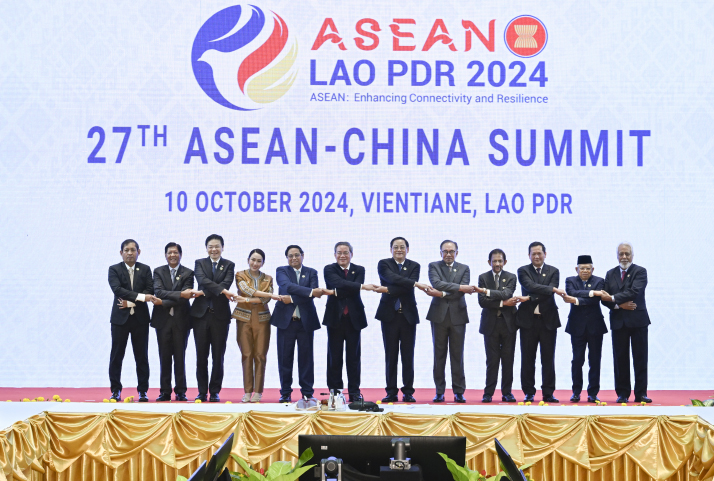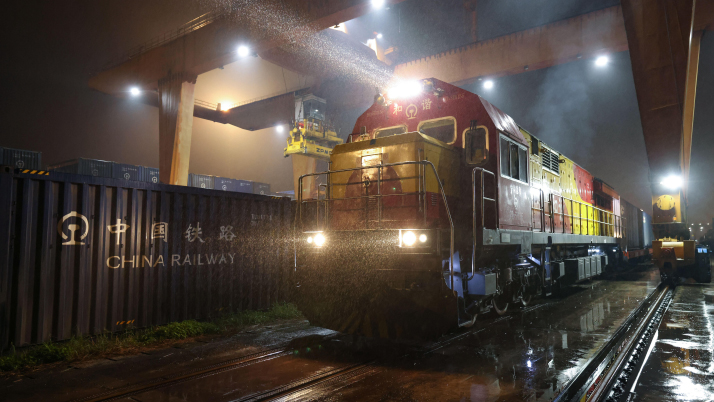| World |
| Recent meetings have seen countries calling for stronger cooperation and promoting common development | |
|
|
 Chinese Premier Li Qiang (sixth left) and ASEAN leaders poses for a group photo before the 27th China-ASEAN Summit in Vientiane, Laos, on October 10 (XINHUA)
Leaders of China and the Association of Southeast Asian Nations (ASEAN) announced the substantial conclusion of the Version 3.0 China-ASEAN Free Trade Area (FTA) upgrade negotiations on October 10. The milestone paves the way for one of the world's most populous and dynamic FTAs to further boost regional development amid rising global protectionism. The announcement was made during the 27th China-ASEAN Summit, part of a series of leaders' meetings on East Asia cooperation that began on October 9. These meetings took place alongside the 44th and 45th ASEAN Summits in Vientiane, Laos, from October 6 to 11. The series also included the 27th ASEAN Plus Three (APT) Summit, attended by the 10 ASEAN member states, along with China, the Republic of Korea and Japan. The 19th East Asia Summit was also convened, bringing together leaders and representatives from ASEAN countries, China, Japan, the Republic of Korea, India, Australia, New Zealand, Russia and the United States. The important outcome provides institutional safeguards for China and ASEAN to build a super-sized market together, Chinese Premier Li Qiang said when addressing the China-ASEAN Summit, hailing it as a big step toward strengthening East Asian economic integration and a clear demonstration of support for multilateralism and free trade. FTA 3.0 in the pipeline With a combined population exceeding 2 billion people, the China-ASEAN market is huge, Yong Chanthalangsy, Laos' representative to the ASEAN Intergovernmental Commission on Human Rights, said, adding "China and ASEAN, geographically close with respective advantages and strong economic complementarity, can support each other and need each other at the same time." "The China-ASEAN FTA 3.0 will make commodity circulation and trade between both sides more convenient, and inject new momentum into their respective economic development," he added. This demonstrates both parties' commitment to maintaining a rules-based trade environment and their dedication to deepening economic integration and pragmatic cooperation in a complex global context, accelerating post-pandemic economic recovery, Du Lan, Deputy Director of the Asia-Pacific Institute at the China Institute of International Studies, told Chinese news portal China.org.cn. The upgraded FTA is expected to further expand mutually beneficial cooperation between China and ASEAN in emerging fields, promote trade facilitation and inclusive development, and boost the integration of the regional economy, she continued. In the first seven months of this year, trade between China and ASEAN countries reached $552 billion, up 7.7 percent year on year, accounting for about one sixth of China's total foreign trade volume in the same period. "This upgrade to the FTA is an important move, especially in this time of growing protectionism in the world. It will send a very clear and important message to everyone on the importance of free trade and win-win market cooperation," said Singapore's Prime Minister Lawrence Wong. The China-ASEAN FTA was established in 2010, with an upgraded Version 2.0 launched in 2019. Negotiations for Version 3.0 began in November 2022, aiming to promote emerging areas such as the digital economy, green economy and supply chain connectivity. The two sides have confirmed they will promote the signing of the 3.0 upgrade protocol next year, the Chinese Ministry of Commerce said.  A train carrying chemicals, machinery and equipment departs for Viet Nam from the Nanning International Railway Port in Nanning, Guangxi Zhuang Autonomous Region, on March 2 (XINHUA)
East Asia cooperation The efforts of China and ASEAN countries are in tune with the theme of the 44th and 45th ASEAN Summits, ASEAN: Enhancing Connectivity and Resilience. This subject highlighted the bloc's ambition to respond to pressing challenges and seize opportunities to build a more integrated, connected, and resilient regional community. Over 90 outcome documents were adopted and noted during the meetings, Prime Minister Sonexay Siphandone of Laos, the 2024 ASEAN Chair for 2024, said. With no fewer than 16 summits convened, the leaders "had frank, candid and constructive discussions on regional and international issues of common interest and concern," Sonexay said during a press conference. "When Asia fares well, the whole world benefits," Premier Li quoted Chinese President Xi Jinping when addressing the 27th APT Summit on October 10, adding China will continue to work with all parties involved to give full play to the APT cooperation mechanism, support ASEAN's centrality in the regional architecture, promote the long-term, sound and stable development of the region, and inject more certainty and positive energy into Asia and the world at large. Today, the Asia-Pacific region is a powerhouse for global development, but its waters have been constantly ruffled due to the region's strategic significance. For instance, Japan, a core U.S. ally, risks sowing more regional discord, or even tensions, as its newly-elected Prime Minister Shigeru Ishiba has proposed the establishment of an "Asian version of the NATO military alliance." On October 5, Indonesia's largest English-language newspaper, The Jakarta Post, published an editorial entitled "No to Asia's NATO," advising Ishiba to "refrain from promoting his grand idea to establish an Asian version of NATO to avoid self-humiliation." "ASEAN will not buy into Ishiba's idea about an Asian NATO. As a group, ASEAN needs Japan as a reliable trading and economic partner, not a military ally that would only exacerbate tensions in the region," the article read. "Asian affairs should be handled by Asian people through consultation, and the future of Asia must be firmly kept in our own hands," Li said. External interference could derail regional cooperation, undermine regional solidarity and stability, and disrupt ASEAN countries' orientation toward development, Wei Ling, a professor of international relations at China's University of International Business and Economics, told Xinhua News Agency. ASEAN countries are seeking cooperation with different nations. However, the bloc is increasingly wary of extraterritorial powers that may incite conflicts and introduce disruptive ideas. Such notions undermine ASEAN's centrality and pose challenges to Southeast Asia's geopolitical security, Chen Xiangmiao, Director of the World Navy Research Center at the National Institute for South China Sea Studies, told Chinese newspaper Global Times. When addressing the 19th East Asia Summit, Li also called on all parties to uphold peace and tranquility, pursue mutual benefit and win-win results, as well as firmly promote opening up and cooperation, to create a brighter future for East Asia and the entire world. Chanthalangsy said the East Asia Summit "has become an important platform for promoting peace and development, injecting confidence into regional peace, stability and cooperation." It is important to enhance the resilience of East Asian cooperation to prevent being blocked by small courtyards with high walls, Xu Liping, a researcher specializing in Southeast Asian studies at the Chinese Academy of Social Sciences, told newspaper China Daily. "East Asia has been an engine of global growth, but now this engine is being undermined by actions of decoupling and disrupting supply chains," Xu said, stressing the need to maintain East Asian cooperation to ensure the region's continuous role being the engine of growth. (Print Edition Title: Asia's Powerhouses Align) Copyedited by Elsbeth van Paridon Comments to mamm@cicgamericas.com |
|
||||||||||||||||||||||||||||||
|